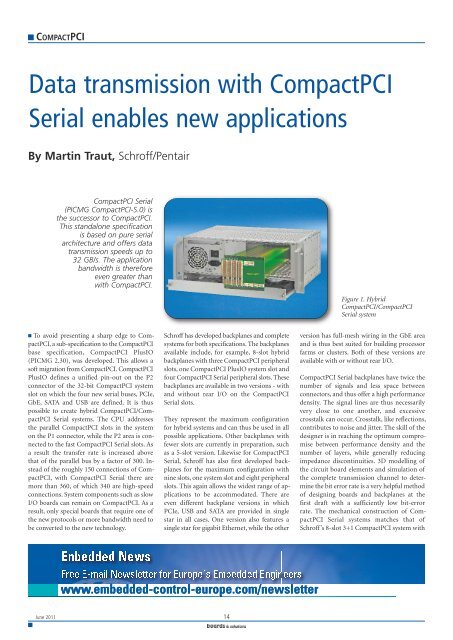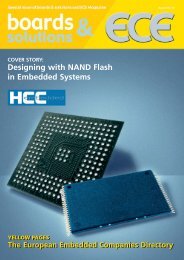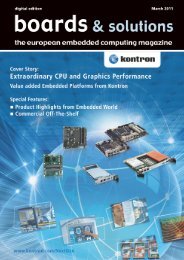in PDF Format - Embedded-Control-Europe.com
in PDF Format - Embedded-Control-Europe.com
in PDF Format - Embedded-Control-Europe.com
Create successful ePaper yourself
Turn your PDF publications into a flip-book with our unique Google optimized e-Paper software.
COMPACTPCI<br />
Data transmission with CompactPCI<br />
Serial enables new applications<br />
By Mart<strong>in</strong> Traut, Schroff/Pentair<br />
CompactPCI Serial<br />
(PICMG CompactPCI-S.0) is<br />
the successor to CompactPCI.<br />
This standalone specification<br />
is based on pure serial<br />
architecture and offers data<br />
transmission speeds up to<br />
32 GB/s. The application<br />
bandwidth is therefore<br />
even greater than<br />
with CompactPCI.<br />
n To avoid present<strong>in</strong>g a sharp edge to CompactPCI,<br />
a sub-specification to the CompactPCI<br />
base specification, CompactPCI PlusIO<br />
(PICMG 2.30), was developed. This allows a<br />
soft migration from CompactPCI. CompactPCI<br />
PlusIO def<strong>in</strong>es a unified p<strong>in</strong>-out on the P2<br />
connector of the 32-bit CompactPCI system<br />
slot on which the four new serial buses, PCIe,<br />
GbE, SATA and USB are def<strong>in</strong>ed. It is thus<br />
possible to create hybrid CompactPCI/CompactPCI<br />
Serial systems. The CPU addresses<br />
the parallel CompactPCI slots <strong>in</strong> the system<br />
on the P1 connector, while the P2 area is connected<br />
to the fast CompactPCI Serial slots. As<br />
a result the transfer rate is <strong>in</strong>creased above<br />
that of the parallel bus by a factor of 300. Instead<br />
of the roughly 150 connections of CompactPCI,<br />
with CompactPCI Serial there are<br />
more than 360, of which 340 are high-speed<br />
connections. System <strong>com</strong>ponents such as slow<br />
I/O boards can rema<strong>in</strong> on CompactPCI. As a<br />
result, only special boards that require one of<br />
the new protocols or more bandwidth need to<br />
be converted to the new technology.<br />
Enbedded News<br />
Schroff has developed backplanes and <strong>com</strong>plete<br />
systems for both specifications. The backplanes<br />
available <strong>in</strong>clude, for example, 8-slot hybrid<br />
backplanes with three CompactPCI peripheral<br />
slots, one CompactPCI PlusIO system slot and<br />
four CompactPCI Serial peripheral slots. These<br />
backplanes are available <strong>in</strong> two versions - with<br />
and without rear I/O on the CompactPCI<br />
Serial slots.<br />
They represent the maximum configuration<br />
for hybrid systems and can thus be used <strong>in</strong> all<br />
possible applications. Other backplanes with<br />
fewer slots are currently <strong>in</strong> preparation, such<br />
as a 5-slot version. Likewise for CompactPCI<br />
Serial, Schroff has also first developed backplanes<br />
for the maximum configuration with<br />
n<strong>in</strong>e slots, one system slot and eight peripheral<br />
slots. This aga<strong>in</strong> allows the widest range of applications<br />
to be ac<strong>com</strong>modated. There are<br />
even different backplane versions <strong>in</strong> which<br />
PCIe, USB and SATA are provided <strong>in</strong> s<strong>in</strong>gle<br />
star <strong>in</strong> all cases. One version also features a<br />
s<strong>in</strong>gle star for gigabit Ethernet, while the other<br />
Free E-mail Newsletter for <strong>Europe</strong>`s <strong>Embedded</strong> Eng<strong>in</strong>eers<br />
www.embedded-control-europe.<strong>com</strong>/newsletter<br />
www www.embedded-controol-europe.<strong>com</strong>/newwsletter<br />
June 2011 14<br />
Figure 1. Hybrid<br />
CompactPCI/CompactPCI<br />
Serial system<br />
version has full-mesh wir<strong>in</strong>g <strong>in</strong> the GbE area<br />
and is thus best suited for build<strong>in</strong>g processor<br />
farms or clusters. Both of these versions are<br />
available with or without rear I/O.<br />
CompactPCI Serial backplanes have twice the<br />
number of signals and less space between<br />
connectors, and thus offer a high performance<br />
density. The signal l<strong>in</strong>es are thus necessarily<br />
very close to one another, and excessive<br />
crosstalk can occur. Crosstalk, like reflections,<br />
contributes to noise and jitter. The skill of the<br />
designer is <strong>in</strong> reach<strong>in</strong>g the optimum <strong>com</strong>promise<br />
between performance density and the<br />
number of layers, while generally reduc<strong>in</strong>g<br />
impedance discont<strong>in</strong>uities. 3D modell<strong>in</strong>g of<br />
the circuit board elements and simulation of<br />
the <strong>com</strong>plete transmission channel to determ<strong>in</strong>e<br />
the bit error rate is a very helpful method<br />
of design<strong>in</strong>g boards and backplanes at the<br />
first draft with a sufficiently low bit-error<br />
rate. The mechanical construction of CompactPCI<br />
Serial systems matches that of<br />
Schroff’s 8-slot 3+1 CompactPCI system with
















